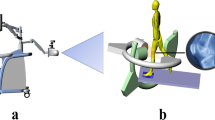Abstract
A semiautomatic three-dimensional knee motion assessment system has been developed based on an optoelectric motion tracking system connected to an IBM-compatible computer. Critical decisions made in implementing the software component of the system include the modelling of the thigh and lower leg segments, calculating the knee angles, reaction forces, and moments; the file structure used and the format of the programs used to process the data are outlined. Once the subject-specific data have been collected, the system of programs requires no other user-intervention during processing. Also, selected curve parameters are automatically extracted from the output and combined with the subject-specific data that include precision X-ray and anthropometric data, which are all added to a knee motion assessment database. The automated portion of the system frees the experimenter from data processing and allows concentration on data analysis.
Similar content being viewed by others
References
Braune, W. andFischer, O. (1889) Über den Schwerpunkt des menschlichen Körpers, mit Rücksicht auf die Ausrüstung des deutschen Infanteristen. (The centre of gravity of the human body as related to the equipment of the German infantry).Abh.d.Math.-Phys' cl.d. K. Sachs. Gesellsch. der Wiss.,26S, 561–672.
Clauser, C. E., McConville, J. T. andYoung, J. W. (1969) Weight, volume and centre of mass of the human body. Aerospace Medical Research Laboratory, Aerospace Medical Division, Tech. Doc. Report No. AMRL-TR-69-70.
Costigan, P. A., Wyss, U. P., Li, J. andDeluzio, K. J. (1990) A technique for the correction of relative joint angles in three-dimesions and adjusting surface markers ‘into’ body segments. Canadian Med. & Biol. Eng. Soc. Conf., Winnipeg, Manitoba, 9th–12th June, 1990.
Deluzio, K. J., Wyss, U. P., Li, J. andCostigan, P. A. (1990) Validation of a three-dimensional motion assessment system. Canadian Med. & Biol. Eng. Soc. Conf. Winnipeg, Manitoba, 9th–12th June 1990.
Grood, E. S. andSuntay, W. J. (1983) A joint coordinate system for the description of three-dimensional motions: application to the knee.J. Biomed. Eng.,105, 136–144.
Kadaba, M. P., Ramakrishnan, H. K., Wootten, M. E., Gainey, J., Gorton, G. andCochran, G. V. B. (1989) Repeatability of kinematic, kinetic, and electromyographic data in normal adult gait.J. Orthop. Res.,7, 849–860.
Northern Digital (1989) Watsmart Manual.V2.7, Chap. 5, 5.
Prodromos, C. C., Andriachhi, T. P. andGalante, J. O. (1985) A relationship between gait and clinical changes following high tibial osteotomy.J. Bone & Joint Surg.,67A, (8), 118–1194.
Siu, D., Chow, D., Fisher, B., McKiven, L. andCooke, T. D. V. (1986) A standardized radiographic method for the assessment of alignment geometry and joint space loss in the knee—The Questor nomenclature. Canadian Orthopaedic Assoc. Meeting, Edmonton, Canada, June 1986.
Stokes, V. P. (1991) A method for the recovery of noisy missing data in movement analysis.Comput. Methods & Programs Biomed.,34, 61–67.
Winter, D. A. (1979) Biomechanics of human movement. John Wiley & Sons, New York, 70–74.
Author information
Authors and Affiliations
Rights and permissions
About this article
Cite this article
Costigan, P.A., Wyss, U.P., Deluzio, K.J. et al. Semiautomatic three-dimensional knee motion assessment system. Med. Biol. Eng. Comput. 30, 343–350 (1992). https://doi.org/10.1007/BF02446973
Received:
Accepted:
Issue Date:
DOI: https://doi.org/10.1007/BF02446973




